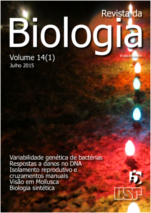DNA damage response following UV-light exposure: putting out the fire before cell collapse
DOI:
https://doi.org/10.7594/revbio.14.01.02Keywords:
Ultraviolet light, DNA reactivity, DNA repair, Xeroderma pigmentosum, Tumorigenesis, Mutagenesis.Abstract
DNA is a reactive molecule and it is estimated that more than 20 thousand lesions are induced endogenously per cell per day, besides other induced by exogenous agents such as ultraviolet light exposure, resulting in physical blockage of DNA replication and transcription machineries. In response to DNA damage, cells activate responses that promote cell cycle regulation and DNA repair, avoiding replication or mitosis catastrophe. If DNA damage exceeds DNA repair capacity, cells induce cell death as last resort. The importance of responses to DNA damage is exemplified by human syndromes with premature aging phenotype and increased risk of cancer, and their study could contribute to understanding of tumorigenesis and development of improved therapies.Downloads
Download data is not yet available.
Downloads
Published
2018-04-23
Issue
Section
Revisão
License
We ensure that our journal does not retain any copyright and that these are exclusive of the author(s) of the text. In that sense, we intend to break any restrictions to the published material and to achieve more intensely our goal of communicating science.
How to Cite
Lima, L. C. de A. (2018). DNA damage response following UV-light exposure: putting out the fire before cell collapse. Revista Da Biologia, 14(1), 6-16. https://doi.org/10.7594/revbio.14.01.02






